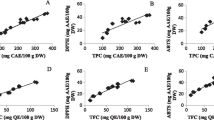Abstract
Anthocyanins gain more and more importance as natural colourants. Besides many other plant species, coloured potatoes could serve as a potential source. Therefore, 27 potato cultivars and four breeding clones of different origin were analysed for their anthocyanin contents in fresh weight (fw). On average the highest amounts of anthocyanins were found in the skin (0.65 g kg−1 fw) of potatoes. The corresponding values of samples taken from whole tubers (0.31 kg−1 fw) and flesh (0.22 kg−1 fw) were significantly lower (p<0.03). The analysis revealed considerable differences in the amounts of anthocyanins between the 31 cultivars/breeding clones. Among them ȁ8Peru Purpleȁ9 revealed the highest anthocyanin content in the skin with 2.96 g kg−1 fw. A similar high value was reached by ȁ8Violettfleischigeȁ9 and clone 1.81.202–92 N. Also for the other two types of samples, flesh and whole tubers, these three genotypes exhibited the highest level of anthocyanins. Interestingly, different rates of nitrogen fertilization at 100 and 200 kg ha−1 had no significant effect on the pigment content of potatoes. The same was observed with respect to the year or the location of plant growth. There were also no significant changes in the anthocyanin contents of tubers during storage for 135 days. In dry matter, starch and protein contents the coloured potato cultivars/breeding clones were comparable with traditional cultivars. Further tests have shown that the glycoalkaloids were mainly localized in the skin of coloured potatoes.
Similar content being viewed by others
References
I.A. Bassa and F.J. Francis, Stability of anthocyanins from sweet potatoes in a model beverage. J. Food Sci. 52 (1987) 1753
C.R. Brown, R. Wrolstad, R. Durst, C.P. Yang and B. Clevidence, Breeding studies in potatoes containing high concentrations of anthocyanins. Am. J. Potato Res. 80 (2003) 241-250
L. Cavalli-Sforza, Biometrie. Jena: Grundzüge biologisch-medizinischer Statistik. Gustav Fischer Verlag (1972).
H. de Groot, Ernährungswissenschaft: Ernährungslehre. VollmerHaan-Gruiten: Europa-Lehrmittel Nourney (2001).
T. Fossen and O.M. Andersen, Anthocyanins from tubers and shoots of the purple potatoSolanum tuberosum. J. Hort. Sci. Biotech. 75 (2000) 360-363
F.J. Francis, Food colorants: Anthocyanins. Crit. Rev. Food Sci. Nutr. 28 (1989) 273-315
M. Friedman and G. McDonald, Potato glycoalkaloids: chemistry analysis, safety, and plant physiology. Crit. Rev. Plant Sci. 16 (1997) 55-132
T. Fuleki and F.J. Francis, Quantitative methods for anthocyanins. 1. Extraction and determination of total anthocyanin in cranberries. J. Food Sci. 33 (1968) 72-77
L. Gao and G. Mazza, Quantitation and distribution of simple and acylated anthocyanins and other phenolics in blueberries. J. Food Sci. 59 (1994) 1057-1059
M.M. Giusti, L.E. Rodriguez-Saona, J.R. Baggett, G.L. Reed, R.W. Durst and R.E. Wrolstad, Anthocyanin pigment composition of red radish cultivars as potential food colorants. J. Food Sci. 63 (1998) 219-224
V. Grassert and H. Lellbach, Untersuchungen des Glykoalkaloidgehaltes von Kartoffelhybriden mit Resistenz gegen die Kartoffelnematoden Globodera rostochiensis und Globodera pallida. Biochem. Physiol. Pflanz. 182 (1987) 473-479
J.B. Harborne, Plant polyphenols : 1. Anthocyanin production in the cultivated potato. Biochem. J. 74 (1960) 262-269
G. Jansen, W. Flamme, K. Schüler and M. Vandrey, Tuber and starch quality of wild and cultivated potato species and cultivars. Potato Res. 44 (2001) 137-146
K. Kaack and T. Austed, Interaction of vitamin C and flavonoids in elderberry (Sambucus nigra L.) during juice processing. Plant Foods Hum. Nutr. 52 (1998) 187-198
D. Kammerer, R. Carle and A. Schieber, Quantification of anthocyanins in black carrot extracts (Daucus carota ssp. sativus var. atrorubens Alef.) and evaluation of their color properties. Eur. Food Res. Technol. 219 (2004) 479-486
C.E. Lewis, J.R.L. Walker and J.E. Lancaster, Changes in anthocyanin, flavonoid and phenolic acid concentrations during development and storage of coloured potato (Solanum tuberosum L.) tubers. J. Sci. Food Agric. 79 (1999) 311-316
C.E. Lewis, J.R.L. Walker, J.E. Lancaster and K.H. Sutton, Determination of anthocyanins, flavonoids and phenolic acids in potatoes. I: Coloured cultivars of Solanum tubersosum L. J. Sci. Food Agric. 77 (1998) 45-57
G. Mazza and E. Miniati, Anthocyanins in Fruits, Vegetables, and Grains. Boca Raton, Florida: CRC Press (1993).
L. Reyes, J. Miller and L. Cisneros-Zevallos, Environmental conditions influence the content and yield of anthocyanins and total phenolics in purple- and red-flesh potatoes during tuber development. Am. J. Potato Res. 81 (2004) 187-193
L.E. Rodriguez-Saona, R.E. Wrolstad and C. Pereira, Glycoalkaloid content and anthocyanin stability to alkaline treatment of red-fleshed potato extracts. J. Food Sci. 64 (1999) 445-450
L.E. Rodriguez-Saona, M.M. Giusti and R.E. Wrolstad, Anthocyanin pigment composition of red-fleshed potatoes. J. Food Sci. 63 (1998) 458-465
H.J. van Eck, J.M.E. Jacobs, P.M.M.M. Vandenberg, W.J. Stiekema and E. Jacobsen, The inheritance of anthocyanin pigmentation in potato (Solanum tuberosum L.) and mapping of tuber skin color loci using RFLPs. Heredity 73 (1994) 410-421
W.M.J. van Gelder, Chemistry, toxicology, and occurrence of steroidal glycoalkaloids: Potential contaminants of the potato (Solanum tuberosum L.). In: A.F.M. Rizk (ed.) Poisonous Plant Contamination of Edible Plants. Boca Raton, Florida: CRC Press (1991) pp. 117-156
B. Watzl, K. Briviba and G. Rechkemmer, Anthocyane. Ernähr.-Umsch. 49 (2002) 148-150
Author information
Authors and Affiliations
Corresponding author
Rights and permissions
About this article
Cite this article
Jansen, G., Flamme, W. Coloured potatoes (Solanum Tuberosum L.) – Anthocyanin Content and Tuber Quality. Genet Resour Crop Evol 53, 1321–1331 (2006). https://doi.org/10.1007/s10722-005-3880-2
Received:
Accepted:
Published:
Issue Date:
DOI: https://doi.org/10.1007/s10722-005-3880-2




